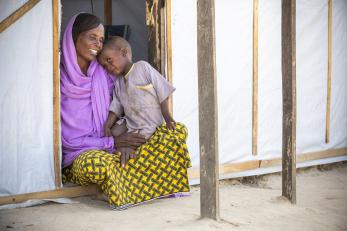Providing shelters against all odds in the Northeast

Today, 1.8 million people are internally displaced in Borno, Adamawa and Yobe States (BAY) in the Northeast region of Nigeria, some living in dire conditions. With the upsurge in violence and forced displacements across the BAY states, over 160,000 people arrived throughout 2019 in already congested camps, stretching a majority of sites to capacity. (Displacement Tracking Matrix, Round 29, November 2019)
What has Mercy Corps been doing about this?
In 2019, Mercy Corps constructed 448 transitional shelters in Ngala Local Government Area (LGA) in Borno state, in addition to the 585 transitional shelters we constructed in 2018, with funding provided by the Office of U.S. Foreign Disaster Assistance bringing it to 1,033 transitional shelters between 2018 and 2019. However, these shelters remained uninhabited until very recently.
Although we had built 585 transitional shelters by September 2018, because of several security conditions and unmet requirements we were banned from relocating participants into the shelters. Some security concerns and requirements cited by the military were a shortage of personnel to serve at the camp, fencing and lightening of the camp, and the absence of a security watchtower.
These requirements to be met by the Presidential Committee for North-East Initiative (PCNI) and other relevant stakeholders were delayed, which meant our program participants to move into the shelters had to keep staying in waterlogged areas of the International Secondary School Internally Displaced Peoples camp in Ngala LGA.
Consequently, the construction of 448 transitional shelters was also hindered which prompted Mercy Corps to lobby some relevant stakeholders like the Camp Coordination and Camp Management (CCCM), Civilian Joint Task Force (CJTF) and National Emergency Management Agency (NEMA) to influence the Nigerian military to lift the restriction affecting the relocation of our participants.
Our efforts proved productive when in November 2019, the military lifted the restriction on the relocation of our program participants and the construction of 448 transitional shelters, which coincided with the reopening of our offices in the Northeast.
What is the current situation?
The relocation of 3,732 individuals into the 1,033 transitional shelters was scheduled to commence on January 18, 2020. Unfortunately, due to a violent attack on the UN Humanitarian Hub by non-state armed group operatives in Ngala on the same day, the relocation was postponed.
On the 21st of January, IOM CCCM and SEMA with support from other actors began the relocation of the participants and we are glad that against all odds, 1,033 households now have a shelter above their heads thanks to the resilient spirit of our team members.